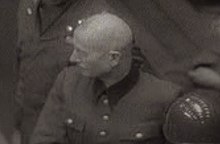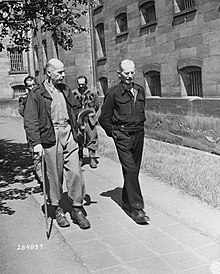Walter Kuntze
Walter Kuntze (born February 23, 1883 in Pritzerbe ; † April 1, 1960 in Detmold ) was a German general of the pioneers in World War II . He was sentenced to life imprisonment in 1948 for his involvement in war crimes in the Balkans, but was released in 1953.
Life until 1933
After graduating from high school and training in mechanical engineering, Kuntze joined the Pioneer Battalion No. 5 of the Prussian Army in Glogau on March 24, 1902 as a flag junior . There he was on 18 October 1902 Ensign and on August 18, 1903 Lieutenant promoted. On October 1, 1905, Kuntze was assigned to the Military Technical Academy in Berlin to further deepen his training. Subsequently, on June 15, 1907, he was assigned to the Pioneer Battalion No. 16 in Metz . On May 17, 1910 he was transferred to the Pioneer Battalion No. 9 in Harburg and from October 1, 1912 to the Pioneer Battalion No. 26 in Graudenz . In the meantime he had been promoted to first lieutenant on August 18, 1911 and sent to the War Academy in Berlin from October 1, 1911 to July 16, 1914 .
With the outbreak of World War I , Kuntze took over as chief of the 2nd company of the battalion on the Eastern Front in East Prussia . In this capacity, Kuntze was promoted to captain on November 8, 1914 and was so badly wounded on November 14 that he was not fit for duty again until May 1917. It was first used at AOK 4, then at AOK 7. On August 2, Kuntze was appointed Ia in the staff of the 4th Cavalry Division and from September 1918 he held the same position in the 89th Division .
After the end of the war, Kuntze was accepted into the Reichswehr , used as a consultant in the Foreign Armies department in the Reichswehr Ministry and promoted to major on April 1, 1923 . As such, he acted from November 1, 1923 as company commander in Pioneer Battalion 3 in Cüstrin and from October 1, 1925 he was a member of the staff of Group Command 1 in Berlin. Kuntze was transferred to Koenigsberg on May 1, 1928 and given command of Pioneer Battalion 1. From there, Lieutenant Colonel Kuntze (since February 1, 1929) returned to the Reichswehr Ministry on March 1, 1930, this time as Chief of Staff the inspection of pioneers and fortresses (In 5). On October 1, 1931, Kuntze was promoted to colonel and, as such, a year later, he was appointed senior engineer officer at Group Command 1.
time of the nationalsocialism
Kuntze was promoted to major general on September 1, 1934, and on May 15, 1935 was entrusted with the leadership of the Münster Division , which had been called the 6th Infantry Division since October 15, 1935 and of which he was in command from that point on.
He was promoted to Lieutenant General on August 1, 1936, and Kuntze gave up command of the division on February 4, 1938, was promoted to General of the Pioneers on February 10, and was appointed commander of the Kaiserslautern command staff on March 1 . In this function, Kuntze was responsible for the exploration and definition of the west wall between Merzig and the Rhine . A short time later, on October 1, he was appointed commanding general of the Saarpfalz border troops.
After the beginning of the Second World War, the General Command was renamed XXIV. Army Corps and Kuntze took over the newly established XXXXII on February 15, 1940 . Army corps , which he commanded in the western campaign and at the beginning of the attack on the Soviet Union in 1941. Kuntze gave up command on October 24, 1941 and was transferred to the Führerreserve for the first time . In charge of the 12th Army from October 29, 1941 , he was also Wehrmacht Commander Southeast until July 3, 1942 . From August 8th to September 14th, 1942, he came back to the Führerreserve and was then chief of training in the replacement army . In this position he remained until March 14, 1945 and became the commanding general of the deputy III. Army corps and commander in military district III appointed.
After 1945
On May 2, 1945, Kuntze fell into British captivity in Mecklenburg and was later handed over to the Americans .
The Allies indicted Kuntze in 1947 in one of the follow-up trials of the Nuremberg Trials against the main war criminals . Kuntze was tried in ( Case VII: Generals in Southeast Europe ) (hostage murder trial). He was next to General Field Marshal Wilhelm List as Wehrmacht Commander Southeast a. a. highest authority for fighting partisans . According to the findings of the court, as Commander-in-Chief, Kuntze was responsible for the executions of thousands of prisoners in camps, justified as a measure of atonement, mainly committed by General Franz Böhme, who was subordinate to him, in 1941. But Kuntze was also held responsible for executions as expiatory measures ordered by himself in 1942. People were shot in camps who were unrelated to attacks previously committed against Germans. In another case, shortly after taking over his new command, von Kuntze's subordinates arrested all “Jews” and “Gypsies” in their area as hostages for atonement. They deported their wives and children to concentration camps. In the war diary of the 433rd Infantry Regiment, which is subordinate to Kuntze, there is a report on November 4, 1941 about the shooting of 3,200 "Jews and Gypsies". The court sentenced Kuntze to life imprisonment in Landsberg Prison . The American High Commissioner John McCloy released him and Wilhelm List on February 10, 1953 due to public pressure to pardon the former Wehrmacht officers sentenced in Nuremberg .
Awards
- Iron Cross (1914) 2nd and 1st class
- Knight's Cross of the Royal House Order of Hohenzollern with swords
- Wound badge (1918) in black
- Bavarian Order of Military Merit IV class with swords
- Hanseatic Cross Hamburg
- Austrian Military Merit Cross III. Class with the war decoration
- Iron crescent
- Officer's Cross of the Bulgarian Military Merit Order
- Clasp for the Iron Cross, 2nd and 1st class
- Knight's Cross of the Iron Cross on October 18, 1941
literature
- Beate Ihmel-Tuchel: Case 7- The trial against the "Süd-Ost Generale" (against Wilhelm List and others) Gerd R. Ueberschär (Hrsg.): National Socialism in front of a court. The allied trials of war criminals and soldiers 1943–1952 . Fischer-Taschenbuch-Verlag, Frankfurt am Main 1999, ISBN 3-596-13589-3 .
- Martin Zöller; Kazimirz Leszczyński Ed .: Case 7 - The hostage murder trial ruled by the United States Military Tribunal V. VEB Verlag der Wissenschaften, Berlin 1965.
- Dermot Bradley : The Generals of the Army 1921–1945. The military careers of the generals, as well as the doctors, veterinarians, intendants, judges and ministerial officials with the rank of general. Volume 7: Knabe-Luz. Biblio Verlag, Bissendorf 2004, ISBN 3-7648-2902-8 , pp. 317-318.
Web links
- Walter Kuntze in the Munzinger archive ( beginning of article freely accessible)
Individual evidence
- ↑ German Lists of Losses (Prussian Loss List No. 95) of December 6, 1914, p. 3412: Pionier-Bataillon No. 26, Graudenz 2. Feld-Kompagnie Lodz on December 14, 1914. from 18 to 20 November 2014. Captain Walter Kuntze - Berlin - slightly wounded.
- ↑ Beate Ihmel-Tuchel: Case 7- The trial against the "Süd-Ost Generale" (against Wilhelm List and others) Gerd R. Ueberschär (Ed.): National Socialism in front of court. The allied trials of war criminals and soldiers 1943–1952 . Fischer-Taschenbuch-Verlag, Frankfurt am Main 1999, ISBN 3-596-13589-3 , p. 152.
- ↑ a b c d e f g h Ranking list of the German Reichsheeres , Ed .: Reichswehrministerium , Mittler & Sohn Verlag, Berlin 1930, p. 116.
- ↑ Veit Scherzer : Knight's Cross bearers 1939-1945. The holders of the Iron Cross of the Army, Air Force, Navy, Waffen-SS, Volkssturm and armed forces allied with Germany according to the documents of the Federal Archives. 2nd Edition. Scherzers Militaer-Verlag, Ranis / Jena 2007, ISBN 978-3-938845-17-2 , p. 485.
| personal data | |
|---|---|
| SURNAME | Kuntze, Walter |
| BRIEF DESCRIPTION | German General of Pioneers in World War II |
| DATE OF BIRTH | February 23, 1883 |
| PLACE OF BIRTH | Splatter leg |
| DATE OF DEATH | April 1, 1960 |
| Place of death | Detmold |

